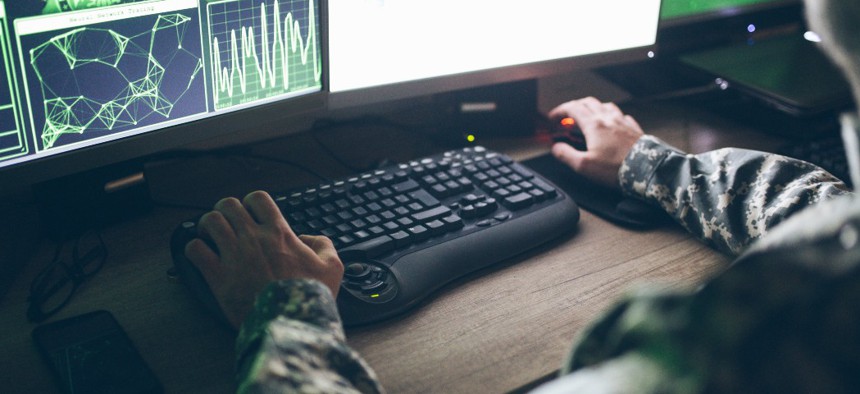DOD Debuts Office to Help It 'Move Faster' on Artificial Intelligence
Two memos clarify the goals of the Chief Digital and Artificial Intelligence Office, which was created to coordinate AI efforts across DOD.
The Defense Department’s Chief Digital and Artificial Intelligence Office, a new hub to align disparate AI-centered pursuits across the vast enterprise, officially reached initial operating capacity this week—but much must still be puzzled out before it’s totally realized this summer.
John Sherman, DOD’s recently Senate-confirmed chief information officer, will play a major role in seeing it through. He’s taking the office’s lead as acting chief digital and AI officer until the department completes its search for the right person to fill this first-of-a-kind position.
“In addition to getting the OCDAO up and running for [full operational capacity], rest assured we'll remain laser-focused on our CIO duties—cybersecurity, digital modernization and other areas the department relies on us for,” Sherman told reporters during a press call on Wednesday. “We're not taking our eye off the ball.”
He and two other senior defense officials shared fresh details about the new unit’s establishment and what it’s ultimately meant to accomplish. Two memorandums signed by Deputy Defense Secretary Kathleen Hicks on Tuesday and released on Wednesday also provide further clarity on the OCDAO’s functions.
The Pentagon in December announced plans to stand up this central office to underpin the integration and synchronization of all data- and AI-associated work, which is primarily led by DOD’s Joint AI Center, office of the chief data officer and Defense Digital Service. Officials intend for the tedious reorganization to eventually provide DOD with “end-to-end” cohesion from the time data is captured, to when it's used for advanced analytics.
The deadline for initial operating capacity, set for Feb. 1, was met this week. Now, officials are working to reach full capacity by June 1.
“Let me just note that the goal here is for data, and data analytics and AI to enable faster and better decision-making, and therefore military advantage from campaigning to conflict,” a senior defense official explained. “As many of you know, China, in particular, is investing aggressively and using these capabilities to offset traditional U.S. advantages, and this is a key part of our efforts to match that pacing threat.”
A memo to Defense leadership announcing that the office reached IOC on time also highlights some of what it will be responsible for during this phase. It notes that officials will need to oversee DOD’s strategy development and policy formulation for data, analytics and AI; break down barriers to technology adoption; produce an enabling infrastructure for digital solutions; and selectively scale existing assets for enterprise and joint use cases for Pentagon components.
On the call, officials said they’re also working at this point to help create “a greater sense of team” among the components involved.
Multiple shifts additionally need to be hashed out before the OCDAO can come to full fruition.
For instance, the IOC memo asserts that the DOD’s chief data officer will continue to report to the CIO for now, in compliance with the 2020 National Defense Authorization Act—but the supporting data office will transfer to the OCDAO. The CDAO is directed in the memo to draft a legislative proposal to permit the CDO to report up to the new office down the line.
The document also confirms that the CDAO has assumed the existing authorities of its component organizations, and the OCDAO is now considered their successor.
Further, it requires DOD’s CDAO to steer a comprehensive review of all authorities and governance structures connected to DOD data, analytics and AI—and provide recommendations for updates to Pentagon leadership by May 1.
Officials on the call noted that, so far, Congress members have been supportive of this ongoing initiative, and are looking forward to DOD “moving faster” in this technological realm.
“I think we have very much appreciated the bipartisan collaborative nature of these engagements with Congress. This is an area where I think in a very polarized time there's just a lot of sort of joint problem solving and figuring out how we can make more rapid progress,” a senior defense official said. “There’s a lot of good ideas coming from experts and staffers on the Hill on where we can start looking for opportunities—and we look forward to continued engagement with them.”
In a separate memo also published Wednesday, the department also sheds light on how this new CDAO role differs from but will work with other DOD positions—such as the CIO and undersecretaries for research, engineering and policy, among others. The hub will clarify and codify its final role within its chartering directive due this summer.
During the call, a senior defense official confirmed the CDAO’s office will have an initial budget of about $500 million and include about 200-to-300 employees from across the massive enterprise.
“It really is a collective ecosystem,” Sherman said. “We had the parts of it, but we’re putting it together in a way we haven’t before to deliver that decision advantage that our leaders need.”
NEXT STORY: SecDef Austin Summons Hypersonics CEOs





